| 1 |
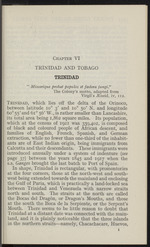 |
“...extraction, while no fewer than one-third of the inhabit-
ants are of East Indian origin, being immigrants from
Calcutta and their descendants. These immigrants were
introduced annually under a system of indenture (see
page 37) between the years 1845 and 1917 when the
s.s. Ganges brought the last batch to Port of Spain.
In shape, Trinidad is rectangular, with promontories
at the four comers, those at the north-west and south-
west being extended towards the mainland and enclosing
the Gulf of Paria, which is practically a land-locked sea
between Trinidad and Venezuela with narrow straits
north and south. The straits at the north are called
the Bocas del Dragón, or Dragon’s Mouths, and those
at the south the Boca de la Serpiente, or the Serpent’s
Mouth. There seems to be little reason to doubt that
Trinidad at a distant date was connected with the main-
land, and it is plainly noticeable that the three islands
in the northern straits—namely, Chacachacare, Huevos,...”
|
|
| 2 |
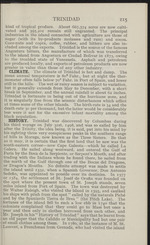 |
“...HISTORY. Trinidad was discovered by Columbus during
I his third voyage on July 31st, 1498, and was so called by him
I after the Trinity, the idea being, it is said, put into his mind by
I his sighting three very conspicuous peaks in the southern range
I of hills in Moruga, now known as the Three Sisters. Be that
I as it may, it is certain that the first land that he saw was the
I south-eastern corner—now Cape Galeota—which he called La
I Galera. He sailed along westward, and entered the Gulf of
I Paria by the Boca de la Serpiente, or Serpent’s Mouth, and after
I trading with the Indians whom he found there, he sailed from
I the north of the Gulf through one of the Bocas del Dragone,
l or Dragon’s Mouths. No definite attempt was made to settle
I the island until 1532, when a Spanish Governor, Don Antonio
jSedeiio, was appointed to preside over its destinies. In 1577
I or 1584, the settlement of St. Joséf de Orufia was founded on
j the spot where the present town of St. Joseph stands, seven
I...”
|
|
| 3 |
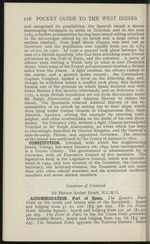 |
“...Spanish issued a decree I
encouraging foreigners to settle in Trinidad, and in the year li
1783, a further proclamation having been issued calling attention I
to the advantages offered by its fertile soil, a large influx of I:
settlers resulted. Don Joséf Maria Chacon was sent out as 11
Governor, and the population rose rapidly from 300 in 1783 1
to 18,000 in 1797. In 1796 a quarrel took place between the I
men of a British squadron, who had been attacking some French I
privateers in the Gulf of Paria, and the colonists. A party of I
officers were visiting a Welsh lady in what is now Frederick I
Street, when some of the French privateersmen insulted a British I
sailor from the A larm. A fight resulted, the officers rushed to I
the rescue, and a general ffielée ensued; the Commodore, 1
Captain Vaughan, landed a force on the following day, and, I
though he withdrew before a conflict took place, -this incident 1
formed one of the grounds on which Spain declared war with I
Great Britain a few months...”
|
|
| 4 |
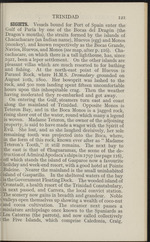 |
“...TRINIDAD i2i
I SIGHTS. Vessels bound for Port of Spain enter the
I Gulf of Paria by one of the Bocas del Dragón (the
I Dragon’s mouths), the straits formed by the islands of
I Chacachacare (an Indian name), Huevos (egg) and Monos
I (monkey), and known respectively as the Bocas Grande,
I Navios, Huevos,and Monos (see map, after p. 116). Cha-
I cachacare, on which there is a tall lighthouse, has, since
I *92I> been a leper settlement. On the other islands are
I pleasant villas which are much resorted to for bathing
I and fishing. At the north-east point of Huevos is
I Parasol Rock, where H.M.S. Dromedary grounded on
■ August ioth, 1800. Her bowsprit was lashed to the
■ rock, and 500 men landing spent fifteen uncomfortable
I hours upon this inhospitable crag. Then the weather
I having moderated they re-embarked and got away.
I On entering the Gulf, steamers turn east and coast
■ along the mainland of Trinidad. Opposite Monos is
■Teteron Bay, and in the Boca Monos is a jagged rock,
■rising...”
|
|
| 5 |
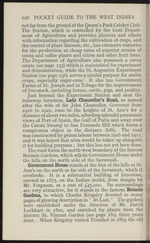 |
“...purpose for arable
crops, especially sugar-cane* It also has Government I
Farms at St. Joseph and in Tobago for the improvement
of live-stock, including horses, cattle, pigs, and poultry. I
Just beyond the Experiment Station and near the I
tramway terminus, Lady Chancellor’s Road, so named I
after the wife of Sir John Chancellor, Governor from I
1916 to 1921, runs to the heights of St. Ann’s for a I
distance of about two miles, affording splendid panoramic I
views of Port of Spain, the Gulf of Paria and away over I
the Caroni Swamp to San Fernando Hill which forms a 1
conspicuous object in the distance (left). The road I
was constructed by prison labour between 1916 and 1921, I
and it was hoped that sites would be taken up alongside I
it for building purposes; but this has not yet been done. 1
The road forms the north-west boundary of the famous I
Botanic Gardens, which adjoin Government House under I
the bills on the north side of the Savannah.
Government House stands at the foot of the...”
|
|
| 6 |
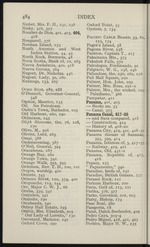 |
“...291-2
Palmer, Mrs., the wicked, 294
" Paludismo,” 366
Pampatar, 411
Panama, 401, 403
— Books on, 33
— Canal, 373
Panama Canal, 417-33
— and Suez compared, 418 ;
— Construction, 424
— History of, 418-20
Panama City, 419, 421, 428-31
Panama disease of bananas,
393. 399, 4r4
Panama, Isthmus of, 3, 417-33
— Railway, 419, 421
Panama, Old, 431-2
Panama, Republic of, 417,
418
Papain, 233
“ Papiamento,” 340
Paradise, birds of, 151
Paradise, British Guiana, 377. ;
Parasol Rock, 121
Parham Harbour, 200
Paria, Gulf of, 115, 121
Parika, 376, 377
Parke, Governor, 201, 205
Parry, Bishop, 174
Paso Real, 360
Passports, 18
Pater, Dutch freebooter, 409
Pedro Cays, 303-4
Pedro Miguel, 418, 421, 427
Peebles, Major H. W., 235...”
|
|
